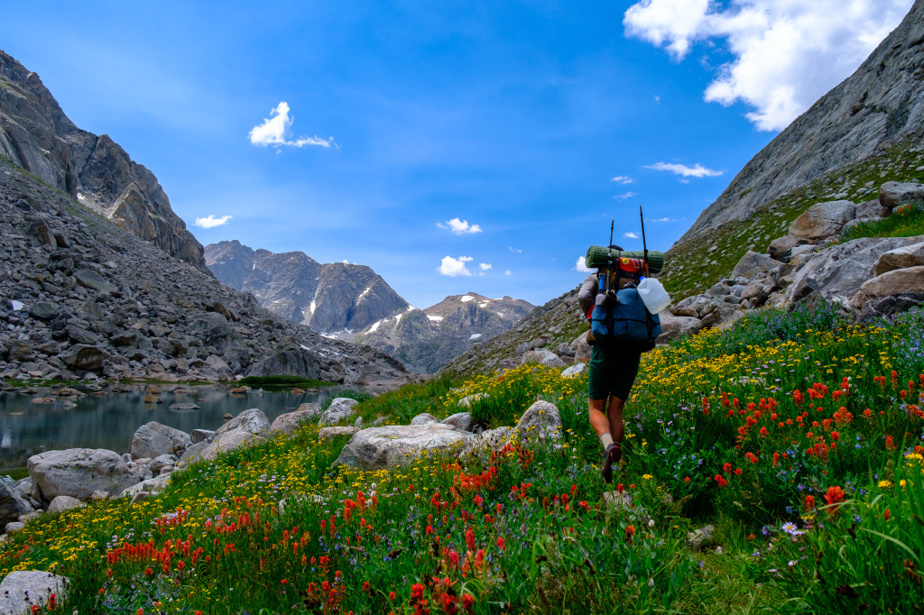Drought, snow-capped peaks, sharp peaks, sheer walls… The Continental Divide Trail (CDT) route multiplies the pitfalls and trials for hikers who dare to tackle it.
Some 150 km of trail and no natural water source. No rivers, no streams, no lakes, no ponds. Nothing. What drought. It doesn’t matter: I’m back home, in the heart of nature, and I walk the Continental Divide Trail (CDT) with humility, in the New Mexico desert. A hostile environment where thorns from bushes, solid as nails, puncture the tires of cars and impale my soles!
Apart from a few water caches maintained by generous strangers, known as “trail angels”, or employees of the CDT coalition, the only sources of water for hikers are those for livestock. Water is thus drawn from reservoirs or huge tires, often containing a dubious liquid, where cows drink.
Brutally dry, then. And warm: 30°C in the shade. No choice to drag liters of water, especially since the reliable sources are far from each other.
Despite this extra weight, I walk with a light heart, with my strings of blisters around my heels. I am at home. The sky is my ceiling, the walls, non-existent.
An oasis in the desert. I must have crossed the Gila River 250 times, often with water up to my knees or even at the fork. A river enclosed in a canyon with rich vegetation and where countless fairy chimneys and huge columns of rocks take pride of place. Some, in shades of pink and red, seem to have been shaped by a potter who has taken care of every curve. Others, rather black and with straight lines, have on the contrary suffered the ardor of a stonecutter who amputated large blocks here and there.
The river meanders, hollows, caresses and kisses each side of the canyon as it flows and breathes, forcing hikers to cross it endlessly. Never have I had so much fun having my shoes soaked!
It is possible, along the CDT, to opt for alternative trails and build your adventure à la carte. The Gila River is not on the continental divide, but remains a must. Another example: hikers will take a shortcut to avoid the El Malpais lava field which, however, is a little gem. In the misshapen folds of the black and crevassed flows grow cacti with red flowers, as well as pines, junipers and stunted oaks, and one treads there rocks with holes like sponges.
It was finally as an outlaw that I traveled my last 80 kilometers in New Mexico, before reaching Colorado, at an altitude of 3200 m. Due to the extreme risk of fires, the United States Forest Service has closed areas. Luckier than many other hikers I was able to complete the trail in this state.
As a warning, it snowed on my last day: Colorado will have nothing to do with these 1000 km of drought.
Her trail name was Cutie. He died peacefully in his sleep in the mountains of Colorado at age 32. Shocking news even though I barely knew him: I had shared a few moments in town with him and other hikers, and only saw him again at a secluded hot spring.
There were four of us basking in this spring nestled near a river, reached after long passages in the snow. If you had seen his sunburn! In the evening, he was sorry that he could no longer see the stars at night, because he had lost his glasses.
The next morning, he got ahead. Two weeks later, this news.
Life hangs by a thread!
He thus left in an ocean of mountains with black, gray, beige or orange sides, where one passes from one pass to another like from one wave to another, with this impression of infinity.
He flew among the jagged, snow-capped peaks, whose granite slopes shimmer in the sun or look threatening under dark clouds.
He observed, from above, these streams which meander in the valleys, these waterfalls which tumble, these lakes which thaw and, finally, these clouds which water them.
He who was sorry to no longer see the stars, he is now one of them.
A star that reminds me of the importance of enjoying every moment, even when I have to brave thunderstorms or move forward among horizontally falling snowflakes. Even when the 46,000 meters of elevation gain — the equivalent of five Mounts Everest — of the 1,200 km CDT in Colorado exhausts me.
It was locked in a furnace in Wyoming that I must have remembered most often to enjoy every moment. Some 300 km to hike in the Great Divide Basin, an arid environment, barely hilly, with unbearable heat. Where the sun burns everything. Where it is impossible to stop in the shade, because there are only rickety sage bushes and yellowed blades of grass. Where the path, which takes dirt roads that seem to have no destination, stretches to infinity. Where you quickly realize, over miles and miles, that you are alone in the world. Where water is stolen from cattle and where the speed of American antelope is envied. And where the hot wind is our only ally, even when it is in front, howling in our ears and whipping us for hours. Without him, I would have ended up roasted. Like a chicken in the oven.
As much as the basin seemed inhospitable to me, the Wind River mountain range, known as Winds, opened its arms to me. Arms tattooed with turquoise lakes, laden with wildflowers and whose fingers of granite scratch the sky. Arms that delicately encircle the path, that welcome pikas and marmots, and in which one would like to stay – especially where they are covered with sun-drenched strawberries!
And what about Yellowstone Park, with its extraordinary nature? Hydrothermal pools compete in bright colors while geysers, including the famous Old Faithful, eject water meters high.
Of all the geysers, one of them, smaller, modest and outside the tourist area, conquered me during an unforgettable encounter during which it spat coquettishly. A friend and I enjoyed our supper — delicious powdered potatoes — with him, feet in a trickle of hot water fueled by his mood swings.
After walking alone, walking with friends and hiking to get to the Canadian border before the cold weather, no way to breeze through Bob Marshall Protected Area and Glacier National Park. I even chose longer journeys to drag me on before a sudden return to normal life.
I gently skirted the Great Wall of China in the United States, a knife-cut 300m escarpment that stretches uninterrupted for more than twenty kilometers.
I took the time to listen to the wind, the waterways and the birds, music to which was added the slab of elk. Their high-pitched, metallic notes twirled in the cool, musky air of dawning autumn.
I did notice the footprints of grizzly bears in the ground or their droppings, gorging myself, too, on ripe blueberries.
I have bathed in glacial lakes while admiring the handiwork of their master builders, the glaciers, which blanketed northern Montana and carved sharp peaks and steep-sided valleys. I brushed past Triple Divide Peak, the only place in the United States where precipitation flows into the Pacific, Atlantic, or Arctic oceans.
I savored every step, every ray of sunshine and (almost) every drop of rain or snowflake.
I gazed up at the starry sky, thinking of Cutie and everyone who had helped me, near or far.
And it was in the rain, after about five months, that I arrived in Canada, soaked and chilled. My heart filled with pride, joy, gratitude and longing, but as heavy as the gray sky at the thought of having to trade my ceiling of the last few months for… real ceilings!
About 90% of hikers hike north from Mexico to Canada, and begin between mid-April and mid-May. Those who walk south start between mid-June and early July. Thru-hikers take five to six months to travel the trail and refuel in villages; sometimes you have to be independent for more than a week. The CDT is part of the Triple Crown, along with the Appalachian Trail (3525 km) and the Pacific Crest Trail (4265 km). This is the most difficult and isolated of the three trails. Some 700 hikers attempted a thru-hike in 2022 and just over 150 reported completing it to the Continental Divide Trail Coalition.
Prepare your trip and find out about the necessary permits before leaving on the official website of the Continental Divide Trail Coalition.
Several resources will help you get your bearings on the spot: the official interactive map of the Continental Divide Trail on FarOut, maps by Jonathan Ley and the Gaia GPS app.
To equip yourself and plan your supplies, here are two resources at your disposal:















